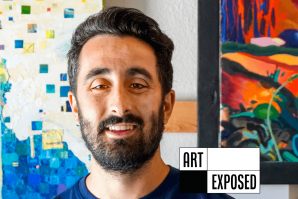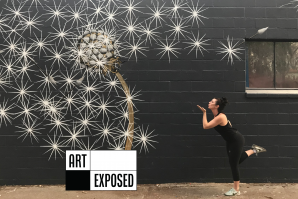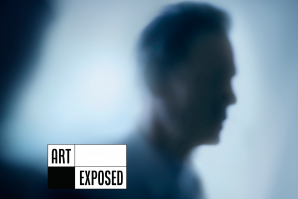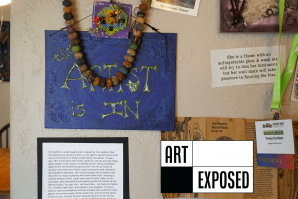“A lot of my work stems from this idea of what I call being stuck in between,” says multidisciplinary Elk Grove artist Taner Pasamehmetoglu.
“My parents both immigrated here from Turkey, and largely for me and my sister to have the opportunity to pursue whatever we wanted, and so growing up that was always very prevalent to me. Feeling that almost burden of privilege to be an American and do all these great things has always kind of stuck with me. So I’m always stuck in between pursuing what that is and just being content with being an artist and exploring my creativity and not feeding this capitalist machine that often is what it means to have an American dream,” Pasamehmetoglu explains.
“The American Dream” is a reflection of the artist’s feeling of
being stuck between two worlds as a second-generation American
and artist pursuing his dreams amid a capitalist society. (Photo
courtesy of Taner Pasamehmetoglu)

His painting, “The American Dream,” is a reflection of that stuckness, though it may not be readily apparent to viewers who see a scene of action: a man in an orange safety vest pushing a row of shopping carts across a parking lot scattered with icebergs. Atop the carts, a battle-ready George Washington captains a crew of rowing soldiers waving an American flag; the painting is part homage, part parody of a 19th-century painting, “Washington Crossing the Delaware”, by German-American artist Emanuel Leutze.
“It’s not entirely this critique of America either,” Pasamehmetoglu says, “because in a way, it’s because of America, it’s because of that freedom of speech, that I’m able to paint something absurd like this and have open conversations about this with people, and it’s not blasphemous in any way.”
A recent artist in residence with the City of Sacramento’s Office of Climate Action & Sustainability, Pasamehmetoglu’s art explores important topics through a sometimes surreal lens. With a bold, vivid style that straddles the line between surrealism and abstract expressionism, his large, colorful works are complex, layered and full of surprises.
His 48-by-36-inch painting “Erosion” depicts an almost apocalyptic view of Yosemite National Park’s iconic granite landmarks looming over a valley filled with advertisements and roadside signs for fast food chains, gas stations, hotels and big box stores.
“Erosion” depicts an almost apocalyptic view of Yosemite National
Park’s iconic granite landmarks looming over a valley filled with
advertisements and roadside signs for fast food chains, gas
stations, hotels and big box stores. (Photo courtesy of Taner
Pasamehmetoglu)

Other works, like “Three Little Birds,” are more abstract. This 39-inch square painting, a thrift store find turned environmental experiment, includes layer upon layer of paint, much of which has been peeled from the surface and reapplied in small blocks of greens, blues, oranges, pinks and neon yellows. Beneath these layered “pixels,” as the artist calls them, are the ghostly impressions of the original imagery — the result of months of exposure to the elements and the artist’s exploration of materials and the environment.
For Pasamehmetoglu, the painting captures his feelings about climate change and how “we lose the things we love,” but it also carries a message of hope and “rebuilding what has been destroyed.”
“Three Little Birds” is a multi-layered piece that explores
climate change through manipulation of the materials by the
artist and the environment. (Photo courtesy of Taner
Pasamehmetoglu)

Pasamehmetoglu, who moved to the area from Salt Lake City in 2020, works in marketing by day and has a degree in strategic communications from the University of Utah. Despite a background in photojournalism and photography, Pasamehmetoglu doesn’t limit himself to representational work, or even just one style, medium, or genre of art. Collaboration is a common thread in his work, from sharing a canvas with his wife to inviting the public to paint alongside him at outdoor events like Midtown’s Second Saturday.
Talk about sustainability in your art and why that’s important to you.
So sustainability has always kind of been something that’s important to me. My dad is a nuclear engineer, and he’s dedicated his life to finding an alternative energy source, a viable energy source. And so growing up raised by my dad specifically, it was always just kind of embedded in us. Sustainability is important. …
I always kind of grew up knowing that things are finite, they’re not abundant, and this doesn’t just go for the environment. This goes for everything. And so I try to incorporate that in my practice too. So I try to upcycle and reuse and minimize my footprint as much as I can in my own process. …
I’ll go get paints from the recycling and reuse center in Sacramento where they give them out for free. Contractors will just drop them off if they have abundance of paint they didn’t use, and it might end up in the landfill otherwise.
I’ll use upcycled canvas, I’ll reuse paintings of mine, even if they’re damaged or whatever. I think that actually adds to the painting rather than reduces its value or whatever. So I’m always just trying to — even if the subject matter of my work isn’t about sustainability, I want that concept in all of my pieces by my own process and by my own kind of attitude about our resources and how finite they are.
Pasamehmetoglu creates in his home studio in Elk Grove. (Photo by
Marie-Elena Schembri)

It doesn’t have to be this confusing, polarizing thing. Really at the heart of it, what it is about is just ensuring that we all can live comfortably and happily and give that to future generations too. That’s what this is all about, and I think we can all agree that that’s something we want. And so if we can create work, if I can create work that helps keep that conversation going, that dialogue going, pique that curiosity for people, those kids that come visit my booth, if we can start a little conversation about sustainability too, that’s awesome. And that’s all I want to have my work be about too.
Tell me about your piece “Erosion.” What was the catalyst for you to create that painting?
So we visited Yosemite and I was just in awe of it. I had never been to a national park that beautiful. Obviously all of our national parks are wonderful, but Yosemite, there’s something really special about it. It is so well preserved, and it’s so beautiful, and I think driving in to Yosemite, you notice the stark difference once you enter the park where there’s no restaurants, there’s no gas stations, there’s no nothing. And so that border where you kind of leave capitalism and enter this natural beauty is just very stark to me. And so entering the park the last time we visited, that’s where the idea struck me. What would it look like if we actually kind of just let developers run rampant? And then it became a kind of fun exercise for me and okay, well, let me just imagine that world, and it’s a doom and gloom. It’s a doomy and gloomy type of imagination thing. …
I really wanted it to feel realistic. I didn’t want it to just feel like this thing that could never exist, because it could exist. That’s the sad reality of it too. And that was also part of the impetus of the piece is my family’s Turkish, and when I hear stories from my family back home about beautiful places that exist in Turkey, like Yosemite, they might not be as grandiose and as beautiful as Yosemite, but they are way more historic.
You’re talking about the center of civilization. Some of these places, they’re thousands, thousands of years of history in these places that they are literally putting parking lots and shopping malls over now. And it crushes my family. It crushes the people of Turkey, and I just think that’s a reality for some people.
This piece that I’m creating here is a reality for people in Turkey. It’s a reality for people in Brazil in the rainforest that, obviously it’s happening there too, where we’re demolishing our rainforest and these beautiful ecosystems. It’s happening around the world, and we can’t just be naive to the fact that it might not happen here. So that piece was really just like, ‘Okay, this is what it could look like. What are we going to do to make sure it never does?’ So that was kind of the impetus for it.
How do you think your residency with the City of Sacramento Office of Climate Action & Sustainability has influenced your creative practice?
I think one thing that I think it did for me is gave me a lot of confidence in my art practice and allowed me to talk about art in a way that wasn’t just so personal and that wasn’t just so about me, but that art is such a universal tool and medium and thing that we all experience and all can benefit from. …
The experience we all had was like, ‘Everybody just thinks we’re muralists and we’re all just going to paint pretty pictures on walls.’ And it’s like half the job was showing that that is not the case at all. There is so much more to art beyond that, and you can leverage art for so many different things.
With a bold, vivid style that straddles the line between
surrealism and abstract expressionism, his large, colorful works
are complex, layered and full of surprises. (Photo by Marie-Elena
Schembri)

I worked with Matt Eierman, who’s the director of public works, on a presentation that he gave to city council during the budget audits. … You would think in that setting that art doesn’t belong at all, and in fact, we were able to create some really cool, meaningful, memorable visuals that help demonstrate some of this data in a way that city council, again, it would be more memorable for them than just graphs and statistics. And that’s just one example of countless ways that I was able to integrate art, integrate creativity in a setting that just almost kind of never considers it. So it gave me the confidence again, that what I’m doing is important. It is helpful, it is universal. …
I think that’s a necessary thing. … Especially in this democratic society, if we want things that represent all of us, it has to include all of us. And so us being artists is part of that, us being creatives, us visual learners, us people who are neurodivergent. I just think there’s so many different things that our structures don’t consider, and art is a really powerful way to break those walls down. And I got to experience that firsthand.
Why do you feel drawn to collaborative artwork?
I think painting is such an interesting medium in that in every other art, every other art form, especially in music and dance, collaboration is very key to it. You go see bands, you go see ballet performances, you go see all these wonderful performances that are collaborative. And yet with painting, we always just kind of assume that painters are these people that are locked in their basement just coming up with weird ideas on their own, and they’re completely isolated. And I hate that. I hate that. That kind of seems pretty prevalent in painting. And so any way that you can invite others to lend different experience, different perspective, especially in the abstract form where it’s all very interpretive and it’s all very based on your own experience, if you have more people in the room, you’re going to create something more interesting in the net because it’s more than just yourself. And it should always be about more than just one person to me. …
Collaborative painting “Make Your Mark,” which Pasamehmetoglu
created during his residency with the City of Sacramento Office
of Climate Action and Sustainability, involved the participation
of over 100 people. (Photo courtesy of Taner Pasamehmetoglu)

Because in every other aspect of society, it requires collaboration. Again, I just came from a government residency. It’s all about ‘How do we all work together?’ It’s all about, ‘How do we represent our constituents?’ And that’s tough, because a lot of us have very different ideas about how our city should be run and about what art should look like, but it doesn’t mean that one is better than the other. It just means you have to reach something that not necessarily appeases everyone, but where you’re learning from one another and you’re taking that into your own thing.
I think when you can work with other people, you have better ideas, you have better perspective, especially in Sacramento where things are so culturally diverse. I love learning about other artists and their pieces that are maybe very, very close to their culture, and it’s not something I’m ever going to recreate, but it gives me better perspective on who they are and what art is to them, and something to be mindful of as I pursue my own art. I think even just that, even just experiencing other people’s art makes you a better artist too. And I think that’s also part of collaboration.
How does your personal philosophy influence your artistic style?
I think personal philosophy is like, things are iterative always, right? And so in my work, I’ve talked about this before, again, just getting back to that, I treat art as, it’s like a ritual. Art is a ritual, and it’s not about creating something. It’s not about the end result. It’s about the process. And I know that’s cheesy, but that is what art is for me. It’s a documentation of just what I’m experiencing through life. And those layers, they speak to depth, they speak to — some days I’m miserable. Some days work is hard.
We’ve recently been grieving a cat that we lost almost a year ago now, and that’s been really hard for us. And when I’m grieving, I paint a lot, and I’m not painting the cat necessarily, or I’m not painting whatever I’m grieving. In fact, you might think I’m always a positive, upbeat person. I use a lot of color in my work, but that color is a way of just taking those emotions and letting them exist and having them exist. And then I might cover ‘em because I’m going to get over that.
I know that as I keep moving forward, I’m going to have some good days ahead. And then those are going to be layers that will add to the painting, and eventually you create something that is complex. It’s diverse, it’s got a lot of range. And I’m not saying my work is this grandiose thing in that way, but that’s the purpose of it for me. I don’t know what’s going to happen with it most of the time, but I know that it’ll be a representation of all these things because I’m just adding more and more to it. …
And my philosophy is just to keep moving forward and just, even if it’s small, little steps, you just keep moving and eventually all these little things you do will create something kind of large that you can look back on and say, “Oh, okay, I’m noticing some themes now.”
You talk about the idea of time and the progression of time in your art. Explain that.
I think in a lot of my pieces, you see it in the layers and the textures. And a lot of the times when I do do that layer and kind of texture style, I like having pieces of the previous layer peek through and just, over and over and over, having these little things peek through. It creates these really, really cool contrasts in color, in texture that you might not otherwise discover or might not otherwise think of, and frankly, don’t subscribe to traditional color theory teachings.
“Home 2.0” is a large collaborative piece Pasamehmetoglu created
with his wife after relocating to Sacramento from Salt Lake City,
incorporating spray paint, oil and acrylic. (Photo courtesy of
Taner Pasamehmetoglu)

A lot of my favorite color combinations are really, really bright pastels and even neon pinks with army and earthy and grungy greens. I don’t know why, but it just appeals to me and stuff like that comes through in work, where that bright pink might represent a really happy day and that grungy green might represent a dull day or whatever, vice versa even. But that comes through in those pieces organically, and it’s not preconceived. And I think that’s a good reflection of time, right? …
If you look at your life in the span of years, in the span of weeks, any increment of time, we’re all such complex beings that you’re never going to have one year where you’re entirely happy every day or you’re entirely satisfied with everything every day. We’re constantly changing. We’re constantly evolving. We’re constantly flawed, we’re constantly nuanced, and that’s what I want to capture in my work. And you can do that through color, you can do that through texture. You can do that through different things. Yeah, I think that’s where the physical meets the conceptual, is what I’m trying to get to at least.
What are you working on or excited about right now?
We’re doing a dedication for “Make Your Mark,” which is the community piece I created for my residency. Over 100 people contributed to this piece called “Make Your Mark.” And yeah, I’m really, really, really just honored that we’re displaying it at Hagginwood Community Center.
And again, it was one of those pieces that we were trying to take, we took data about extreme heat days in Sacramento. We wanted to kind of enlighten people on this issue and show people what you could do. And so each of the cool colors that were available to use on the painting represented a heat-mitigating or emission-reducing tactic. And the surface started in extreme heat colors — oranges and reds and yellows. …
It became a really cool piece. I’m really excited that we got a lot of engagement with it. A lot of people had conversations with me and my team about not only art, but the heat crisis here in Sacramento that we’re facing, and yeah, so Hagginwood Community Center, we’re going to display it there. That is happening on September 13th at 3:30 p.m. So yeah, I’m excited about that.
Edited for length and clarity.
Stay up to date on art and culture in the Capital Region: Follow @comstocksmag on Instagram!
Recommended For You

Art Exposed: Taner Pasamehmetoglu
For this second-generation American, art is a tool to address finite resources and break down walls
“A lot of my work stems from this idea of what I call being stuck in between,” says multidisciplinary Elk Grove artist Taner Pasamehmetoglu.

Art Exposed: Maren Conrad
Meet the Sacramento muralist and designer who creates joyful spaces for women
Maren Conrad reflects on her iconic Sacramento murals and her latest project, the Jacquelyn.

Art Exposed: Doug Winter
Elk Grove photographer creates images exploring perception and memory through the lens of visual impairment
After suffering a stroke in his right eye in 2012, Elk Grove resident Doug Winter, a trained commercial photographer, began to think differently about sight and perception.

Art Exposed: Tracy ‘Indi’ Carlton
Meet the Amador County artist who traded in a 21-year nonprofit career to become a creative expression coach
Tracy Carlton took an unconventional path to her art career, launching a as a creative expression coach and teacher last year following a 21-year career at First 5 Amador, the Amador County branch of the statewide nonprofit commission dedicated to improving early childhood development.



